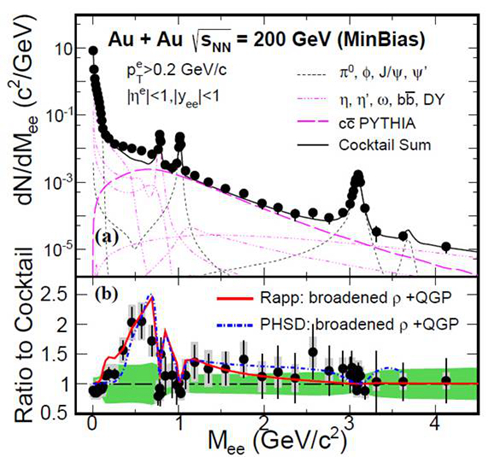Progress on the Dielectron Measurements in Relativistic Heavy Ion Collisions
The mission of ultra-relativistic heavy ion program is to study the QCD matter at the finite temperature and density in laboratory. Probes that have been explored in experiments are mostly hadrons, which have been used to demonstrate the formation of strong-coupling Quark Gluon Plasma (sQGP) in the RHIC and LHC heavy ion collisions. Electromagnetic probes (e.g. Dileptons, photons) can escape from the system without further strong interaction once they are produced, therefore they can offer clean information on various stages during the whole system evolution.
Recently, a Graduated Ph.D. student, Dr. Jie Zhao from Shanghai Institute of Applied Physics, Chinese Academy of Sciences (now a postdoc at Central China Normal University), under supervision of Prof. Yu-Gang Ma and Prof. Nu Xu, work with Dr. Xin Dong from Lawrence Berkeley National Lab, Dr. Lijuan Ruan, Dr. Bingchu Huang from Brookhaven National Lab, and Dr. Yifei Zhang, Dr. Zebo Tang, Yi Guo from University of Science and Technology of China, et al. made the first measurement of the dielectron production at top RHIC energy in Au+Au collisions at STAR experiment. With the comparison to the theoretical model, they found that, in the intermediate (1-3 GeV^2) mass range the dielectrons are mostly originated from the decay leptons of charm pairs. In the lower (0.30–0.76 GeV^2) mass region, there exists a clear excess over the hadronic cocktail that cannot be explained by a pure vacuum rho-meson. This enhancement is significantly lower than what has been reported by the PHENIX experiment. The excess yields in the $\rho$ region exhibit a strong growth with more central collisions. Theoretical model calculations that include a broadened $\rho$ spectral function from interactions with the hadronic medium can describe the STAR measured dielectron excess at the low mass region.
This work has been recently published on Physical Review Letters (Phys. Rev. Lett. 113, 022301(2014)). This work is partly supported by the Ministry of Science and Technology of China (the Major State Basic Research Development Program - No. 2014CB845400), the NSF of China, Chinese Academy of Sciences, and Ministry of Education of China.

(Fig.(a):dielectron invariant mass spectrum, Fig.(b): low-mass dielectron enhancement)

